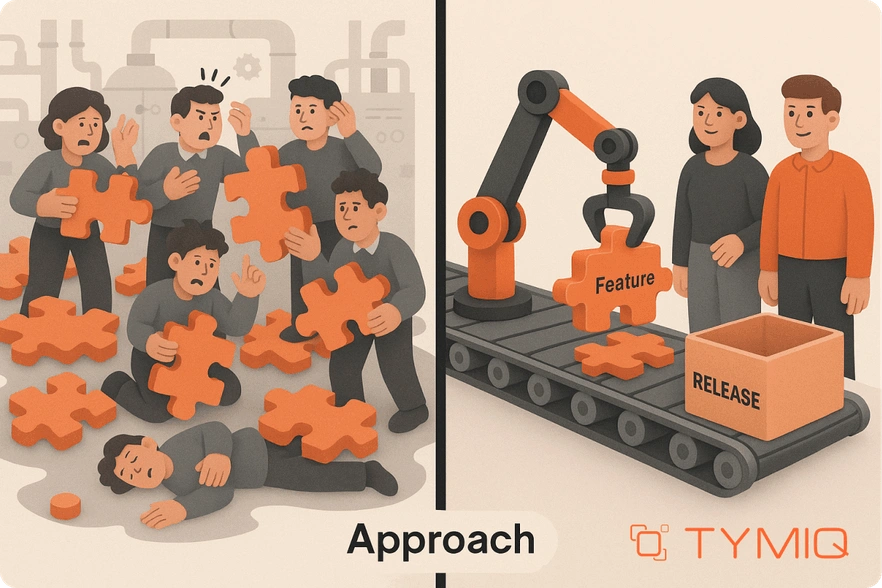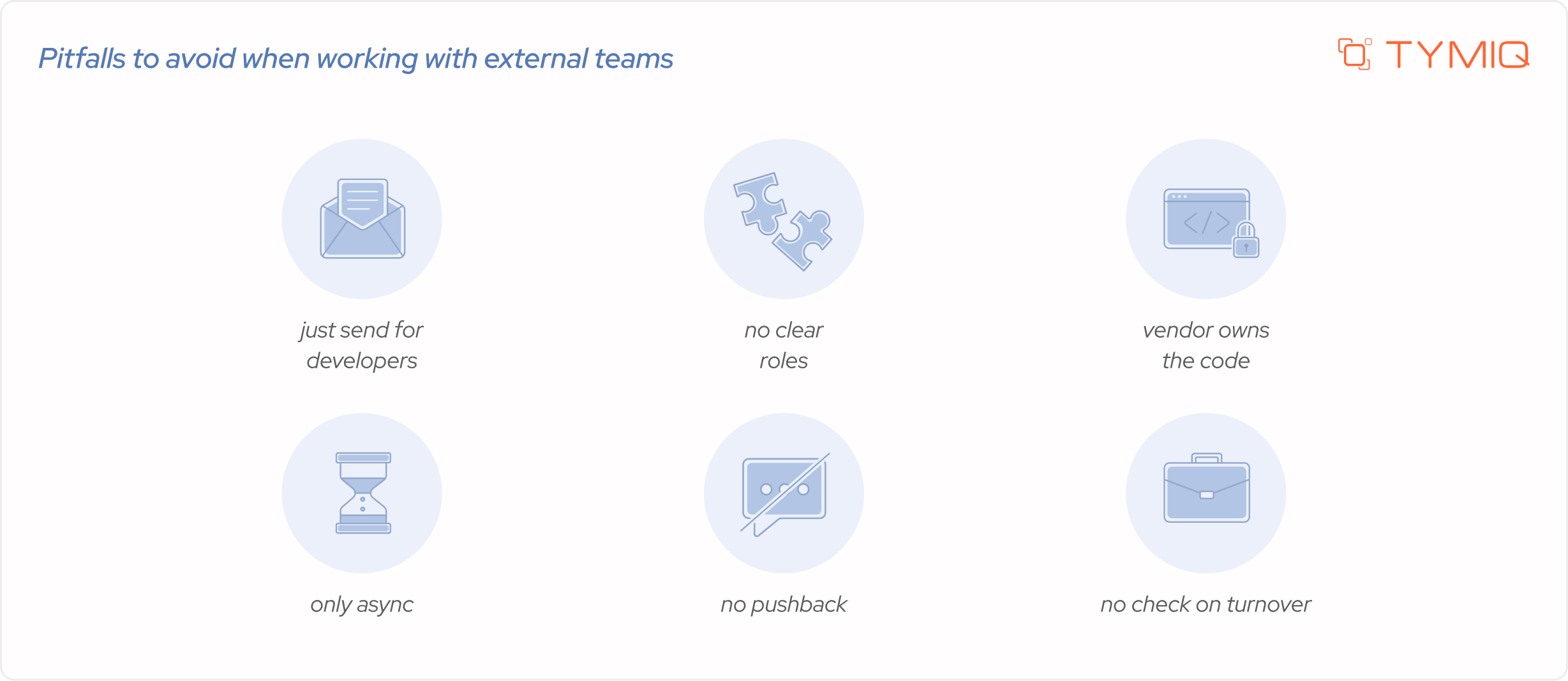Why don’t more engineers always mean more progress
Most teams don’t need more developers. They need fewer slowdowns.
Hiring can stretch for 6 to 12 weeks just to make an offer, then another month before someone’s pushing meaningful code. By the time a new developer is productive, the deadline may already be behind you.
Staff augmentation promises relief. But most traditional models fall short. You get extra hands, not real momentum. Developers arrive without context, float outside your process, and rarely take ownership of the outcome.
Smart augmentation flips that model. It treats external support as an extension of your in-house team. Pods (dedicated, outsourced software development teams that work as an extension of your in-house crew) arrive pre-loaded with Dev, QA, and DevOps. They integrate into your standups, pull from your backlog, and measure impact from day one.
In this guide, we’ll explore when smart augmentation works and when legacy fails, as well as how leading teams scale throughput without scaling chaos.
What’s wrong with traditional hiring and augmentation

1. The fixed headcount trap: You might have a budget, but that doesn’t mean you can scale fast.
Hiring full-time roles may look like an adequate move here, but it drags timelines. Internal teams lose speed during onboarding, handovers, and HR cycles. You’re locked into long processes just to get back to where you started.
2. Transactional staff augmentation falls flat: Plenty of vendors will place developers. Few take responsibility.
These setups often focus on ticket delivery, not outcomes. Without true ownership, you’re scaling coordination overhead instead of delivery. You lose iteration cycles, you miss the learning loops, and you end up managing people instead of shipping product.
3. Black-box outsourcing promises speed and scale — on paper. But in practice, it often delivers vague updates, low accountability, and teams that agree to everything without question.
What looks like a boost at first usually hides delayed feedback, unclear ownership, and rework waiting to happen.

Case insight
Ascendix started with teams in India and China. But the 10+ hour time zone lag dragged response times and decision loops. Shifting to LATAM fixed the overlap, but new problems followed: rotating contributors, shallow product context, and no one challenging flawed specs. Releases slowed by 3–4 weeks, rework jumped 25%.
This is where Smart Augmentation made the difference. Pods came embedded, aligned on outcomes, and stayed consistent across sprints, cutting delivery lag and stabilizing quality without overloading internal teams.
Smart augmentation: a new operating system for scaling delivery
Team augmentation doesn’t have to mean rented hands and spreadsheet management. The smart version installs a real delivery engine inside your roadmap. One that integrates with your rituals, shares your goals, and gets work done without extra drag.
This model isn’t about filling gaps. It’s about owning outcomes. Here’s what makes it different:
New perspective
It’s about reducing the things that keep CTOs up at night.
- Risk sits with the vendor. Compliance issues, contract disputes, and underperformance? That’s on them, not you.
- Budget stays clean. OpEx spend often clears faster than headcount—and doesn't bloat your long-term payroll.
- $150/hour sounds high until you realize there's no HR drag, no recruiting delay, no team churn to recover from.
- If something breaks, you escalate. And the vendor fixes it. Your core team stays focused on building.
Smart augmentation is a protection of your timeline, budget, and roadmap without overloading your team.
Vendor models compared: from “staff” to “smart”
There’s a big difference between renting hands and deploying a delivery engine. Here’s how traditional models compare to smart augmentation when it comes to speed, control, and business impact.
5 situations where smart augmentation wins
There’s a time to hire. And there’s a time to skip the HR maze, avoid the rework trap, and drop in a pod that’s ready to move.
When smart augmentation doesn’t fit
Smart augmentation works best when it’s embedded into a team with clear goals, strong rituals, and continuous delivery needs. But it’s not a fix-all. Here’s when this model is wrong or premature.
If no one on your side is accountable for priorities, scope, or delivery alignment, the pod won’t deliver at full velocity. Smart augmentation requires an internal anchor (whether that’s a tech lead, PM, or EM) to steer context and unblock decisions.
“Let’s just see how it goes, then assign someone.”
Smart pods are built for execution, not figuring out what to build. If your backlog is half-baked, roadmap uncertain, or priorities change week to week without grooming, expect misalignment.
Run a discovery sprint or bring in product strategy support first.
If your team depends on full-time overlap or co-located work, a hybrid pod, even one with overlap hours, can feel out of sync. Smart aug thrives in teams comfortable with async docs, updates, and rituals.
Local contractors or colocated temp staff.
Smart pods take setup: kickoff, access, context, integration. If you need a bug fix or a 10-day audit, you’ll spend more ramping than building.
Task marketplaces or lightweight consulting teams.
Looking for a plug-and-play vendor who disappears with the spec and comes back with magic? That’s not smart aug. The model is collaborative: pods sync, align, and contribute to your way of working.
Fully managed service or outsourced build team.
Managing mixed teams without chaos

Blending internal and external engineers isn’t about productivity. It’s about making them one team, not two camps of “in-house” and “outsourced.” Done wrong, it introduces communication drag, duplicated work, and mistrust. Done right, it boosts flexibility, fills critical gaps, and gets you to outcomes faster.
Here’s your short, practical playbook:
1. Assign a pod owner or internal champion: Every pod should report to one accountable stakeholder inside your org. This person owns alignment, unblockers, and escalation, and makes sure the team doesn’t become a black box.
2. Define sync vs async rituals: Mix daily check-ins with structured async updates (Slack threads, Notion logs, automated JIRA snapshots). Don’t overload meetings, but don’t go dark either.
3. Integrate pods into culture: Add them to your Slack channels. Loop them into retros and planning calls. Share memes, inside jokes, and roadmap shifts. The more context they absorb, the faster they ship.
4. Maintain code and knowledge access: Ensure pods have full repo access, shared dashboards, and context docs from day one. If they don’t have visibility, they’ll guess what costs time.
5. Track retention and velocity: Use tools like Chrono or custom dashboards to track pod retention, velocity trends, and contributor fatigue. Early detection is cheaper than recovery.
Insight:
“A well-integrated pod can outperform internal teams by 20–30%, but only if you treat them like part of the team, not temps.” - Based on integration data from TYMIQ engagements, 2023–2025.
Before and after: How smart augmentation rescued a healthtech QA pipeline
Before
A mid-size healthtech company had its core product team bogged down with broken test infrastructure. Developers spent more time debugging flaky CI pipelines than shipping new features. QA cycles were unpredictable, and regression bugs slipped into production: not ideal when HIPAA compliance is on the line.
After
TYMIQ deployed a dedicated QA pod with Cypress expertise and HIPAA familiarity. The team rebuilt test coverage from the ground up, stabilized flaky cases, and established CI/CD quality gates integrated with staging.
The result
- Test pass rate improved by 93%
- Production defects dropped by 61%
- Product team refocused on the roadmap within 3 sprints
This delivery ownership freed up the internal team to move again.
Pitfalls to avoid when working with external teams

Even with a great model, things can go sideways if you hit these common issues:
- “Just send us 4 developers.” → No real ownership: You’ll get bodies, not outcomes, and end up managing everything yourself.
- No clear roles → Confusion and delays: If no one knows who’s responsible for what, stuff falls through the cracks.
- Vendor owns the code → You lose control: Make sure you have full access and ownership from day one.
- Only async communication → Slow feedback, slower progress: Without some real-time overlap, reviews and fixes take way longer.
- No check on team turnover → Projects fall apart mid-way: If key people leave and there’s no backup plan, delivery stalls.
- Vendor never pushes back → No real thinking: A good partner will question bad specs, instead of just saying yes to everything.
Cultural and strategic fit: interview checklist
Even the most technically sound vendor can derail your project if they’re not aligned with your working style. These questions help uncover whether a partner can truly integrate, or if you’re just adding more noise.
Use this checklist in every vendor interview:

“How many hours of real-time overlap will we have daily?”
Time zone differences can kill impulse. You need enough live collaboration time for efficient cooperation.

"Do your pods join demos, retros, and standups?”
Embedded pods act like part of your team. If they don’t show up to rituals, they won’t share context or accountability.

“Who owns knowledge transfer and release rituals?”
Without clear ownership of documentation, releases, and onboarding, handoffs get sloppy and technical debt piles up.

“What’s your average pod tenure with clients?”
Frequent team swaps usually mean unstable delivery. Long partnerships signal reliability and low churn.

“Have you ever turned down a feature due to bad specs? Why?”
A strong partner will challenge unclear or risky requirements. If they’ve never said no, they’re probably not thinking critically.
Reality check: what you’re actually buying

It’s easy to fall into old assumptions about staff augmentation. Here’s what the surface-level thinking gets wrong and what’s actually at stake.
Ready to scale without the bloat?
Why lock yourself into another hiring cycle when what you really need is a soft push?
Add throughput instead of just headcount.
Bring in a sprint-ready TYMIQ pod and start shipping before your next FTE even clears onboarding.
- Book a pod consultation, scoped in days, delivering in weeks.
- Still deciding? See how smart augmentation stacks up in our previous article: The hidden costs of choosing the wrong tech vendor (and how to avoid them).











.svg)

